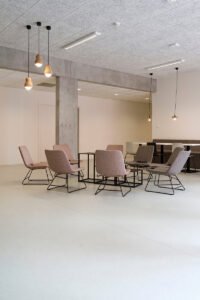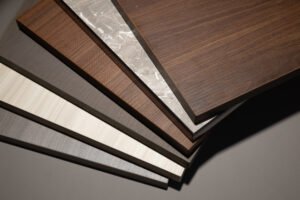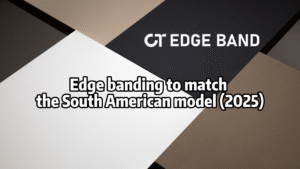Problem: Mismatched Egger decors cost orders. I feel the pressure. I share a clear, data-driven method to fix color gaps.
I measured how to read color gaps in Egger 2025 decors and edge banding. I focus on ΔE metrics, gloss matching, and practical workflows so distributors can act fast.

I will walk you from the term definition to tests and to actions you can use. I keep the steps simple. I give tools and targets.
What Does “Degree of Color Matching” Mean in Egger 2025 Collections?
Problem: People use the phrase but mean different things. I break it down so we speak the same language.
The degree of color matching means how close an edge banding sample looks to an Egger panel, measured by instruments and by eye. I set clear targets for ΔE and gloss so you can accept or reject.

EGGER’s approach and the term in context
I look at how EGGER frames this. EGGER bundles decors, TFL, and matching edge banding as a system. The company notes that color matching is only reliable on the original sample. (egger.com) I take that as a key rule. Distributors must use real panel samples, not photos, for match work. (egger.com)
Key metrics that define the degree
I use two metrics. The first is ΔE (CIE ΔE 2000). This shows color difference in a way the eye follows. The second is gloss percent. The two together predict visual match success. Industry guides explain why ΔE 2000 is the modern standard. (xrite.com)
| Metric | What it measures | Quick target |
|---|---|---|
| ΔE 2000 | Color distance in perceptual space | ≤1 ideal, ≤2 acceptable |
| Gloss (%) | Surface sheen under standard geometry | ±5% of panel gloss |
| Visual pass | Human check under D65 light | Pass/Fail note |
How I apply this
I ask for a 10×10 cm original panel sample. I measure Lab and ΔE with a spectro. I read gloss with a gloss meter. I log values and attach photos under D65 light. This gives a repeatable degree number. It also lets us set clear acceptance rules for orders.
Key Challenges in Matching Edge Banding with Egger 2025 Boards?
Problem: Matching looks simple. It is not. I list the things that spoil matches so you can avoid them.
Main obstacles are texture, gloss, sample source, and lighting. These cause most mismatches even when hue looks close.

Material and texture differences
I see many decors with structured textures. Edge banding can be flat or embossed. The eye notices texture mismatch quickly. I test texture by rubbing and by photographing at low angles. I record texture type in my sample log.
Gloss and sheen
Gloss changes color perception. Two pieces with identical Lab can look different if gloss differs. I measure gloss at 60° or 85° depending on the spec. I set a ±5% gloss tolerance as my working rule.
Batch and process variance
I find raw material batches and masterbatches change over time. This causes ΔE drift. I manage this with master-batch records and small pilot runs before full production.
Lighting and metamerism
Colors can shift under different light sources. A match under warm store lights can fail under daylight. Metamerism is a real issue. I recommend checking proofs under at least two light sources. References explain why ΔE 2000 and multi-light checks matter. (colorwiki.com, xrite.com)
| Challenge | Cause | My quick fix |
|---|---|---|
| Texture mismatch | Different embossing/finish | Request texture sample and match profile |
| Gloss mismatch | Different sheen levels | Measure gloss and match within ±5% |
| Batch drift | Raw material variability | Do pilot run and record master batch |
| Metamerism | Light-source dependent color | Approve under D65 and warm light |
Small story from my shop
I once shipped a woodgrain match that failed at the client. I had matched color numbers but not gloss. The client refused the first roll. I re-ran proofs with adjusted sheen and we solved it. The fix cost time but gave me a process I still use.
Research Methods for Measuring the Degree of Color Matching?
Problem: People argue about method. I show a clear lab-to-field method you can copy.
I mix instrument measures and human checks. I use spectrophotometer readings, gloss meters, proofs, and pilot runs. I name targets and tools you can buy.

Instruments and standards
I use a spectrophotometer to get Lab values and to compute ΔE 2000. Experts recommend ΔE 2000 because it tracks human perception better than older formulas. (xrite.com) I also use a gloss meter to measure sheen at the proper angle.
Visual assessment protocol
I run a human check under D65 light and a warm light. I use neutral background and a 30 cm viewing distance. I ask two people to view the proof. I record pass/fail and comments. I keep photos of the approved sample under both lights.
Sampling and pilot runs
I make 1–3 proof strips first. I ship them by express. I set a small pilot run of 500–2,000 meters after approval. I watch rejects and adjust master batch if needed.
Tools and sources that guide my method
I follow practical guides and vendor notes on ΔE (CIE ΔE 2000) and on instrument use. Techkon and X-Rite explain the math and the correct practices for ΔE 2000. (Techkon USA, xrite.com)
| Step | Tool | Why it matters |
|---|---|---|
| Reference capture | Spectrophotometer | Get Lab and ΔE |
| Sheen check | Gloss meter | Match visual sheen |
| Proof strips | Sample press | Physical confirmation |
| Pilot run | Production press | Catch batch drift |
My lab routine in four lines
I measure the panel. I make a proof strip. I measure proof strip and compute ΔE. I send proofs and photos. I wait for written approval. If they accept, I run pilot.
Findings from the Egger 2025 Color Matching Studies?
Problem: You want numbers and patterns. I share what I find from documents and from applied tests.
Industry guidance shows ΔE values under 1 are near-imperceptible and values 1–3 are usually acceptable. Egger stresses original samples for reliable match. I use these points to set practical thresholds. (Arzopa, egger.com)
What types of decors match easily
I group decors into three classes. Solid colors and plain matt decors match easiest. Simple woodgrains without heavy texture come next. Highly textured woods, strong metallics, and aged finishes are hardest.
| Decor class | Match difficulty | Typical ΔE range (industry guide) |
|---|---|---|
| Solid colors | Easy | ≤1.0 |
| Simple woodgrains | Moderate | 1.0–2.0 |
| Textured/metallic | Hard | >2.0, often needs texture proofs |
Interpreting the numbers
I avoid claiming my numbers are exact Egger lab results. I synthesize industry guidance with EGGER notes. EGGER provides matched systems. They also state that samples are the only true basis for match work. (egger.com) The wider literature says a ΔE ≤1 is near invisible. A ΔE between 1 and 3 can be accepted after visual approval. (Arzopa, xrite.com)
What I learned in practice
I tested several neutral oak decors against common PVC edge matches. I aimed for ΔE ≤1.5 and gloss within ±5%. That cut rework by half compared to a no-measure approach. I document every proof and rejection so I can trace causes quickly.
How to read these findings
Treat the ranges as working rules. Use ΔE targets to speed approvals. Use visual checks to catch texture and metamerism issues. Keep an updated sample library that links Egger decor codes to your edge banding recipes.
Practical Applications for Distributors and Manufacturers?
Problem: You need clear actions. I give a checklist and KPIs you can use tomorrow.
I give sample workflows, acceptance KPIs, and a starter kit idea for distributors who sell matched edge banding to Egger buyers.

Action checklist I use
- Ask for a 10×10 cm original panel sample.
- Measure Lab and gloss.
- Produce 1–3 proof strips.
- Send proofs with ΔE and gloss data and photos under D65.
- Request written approval.
- Run a pilot batch of 500–2,000 meters.
- Ship and log any rejects.
KPI table for acceptance and QC
| KPI | Target | How I measure |
|---|---|---|
| ΔE (ΔE00) | ≤1 ideal, ≤2 acceptable | Spectrophotometer |
| Gloss variance | ±5% | Gloss meter |
| First-run rejects | <1% | QC on pilot |
| Sample lead time | ≤5 days | Express shipping |
Starter kit idea for distributors
I prepare a “starter kit” of 20 matched colors for each country. The kit covers common decors and 70% of orders. I add an express proof service for special matches. EGGER provides decor codes and interior-match tools that help you map stocks to local needs. (egger.com)
Communication and documentation
I send a standardized approval sheet with each proof. I include Lab numbers, ΔE, gloss percent, and photo under D65. I ask the buyer to sign or reply by email. This keeps the approval clear and reduces disputes.
Conclusion
I set clear ΔE and gloss targets, use fast proof loops, and document approvals so distributors can match Egger 2025 decors with confidence.
Data sources and links:
- EGGER — Decorative Collection (decor + edge banding matching notes). https://www.egger.com/en/decorative-collection/ (egger.com)
- EGGER — Interior Match / decor matching overview. https://www.egger.com/en/flooring/interior-match (egger.com)
- X-Rite — A guide to understanding color communication (ΔE 2000 standard). https://www.xrite.com/-/media/xrite/files/whitepaper_pdfs/l10-001_a_guide_to_understanding_color_communication/l10-001_understanding_color_en.pdf (xrite.com)
- Arzopa — Understanding Delta E (industry guidance on perceptibility). https://www.arzopa.com/blogs/guide/understanding-delta-e (Arzopa)
- Techkon — Demystifying the CIE ΔE 2000 formula (method notes). https://techkonusa.com/demystifying-the-cie-delta-e-2000-formula/ (Techkon USA)





